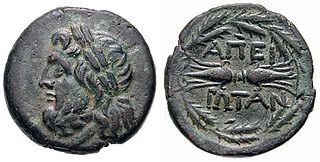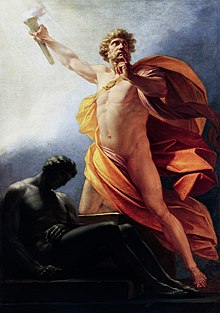
Henry Alfred Kissinger was an American diplomat, political scientist, geopolitical consultant, and politician who served as the United States secretary of state and national security advisor in the presidential administrations of Richard Nixon and Gerald Ford between 1969 and 1977.

In Greek mythology, Prometheus is sometimes referred to as the God of Fire. Prometheus is best known for defying the Olympian gods by stealing fire from them and giving it to humanity in the form of technology, knowledge, and more generally, civilization.

A thunderbolt or lightning bolt is a symbolic representation of lightning when accompanied by a loud thunderclap. In Indo-European mythology, the thunderbolt was identified with the 'Sky Father'; this association is also found in later Hellenic representations of Zeus and Vedic descriptions of the vajra wielded by the god Indra. It may have been a symbol of cosmic order, as expressed in the fragment from Heraclitus describing "the Thunderbolt that steers the course of all things".
Māui or Maui is the great culture hero and trickster in Polynesian mythology. Very rarely was Māui actually worshipped, being less of a deity (Demigod) and more of a folk hero. His origins vary from culture to culture, but many of his main exploits remain relatively similar.
Tangaroa is the great atua of the sea, lakes, rivers, and creatures that live within them, especially fish, in Māori mythology. As Tangaroa-whakamau-tai he exercises control over the tides. He is sometimes depicted as a whale.

In Hawaiian mythology, Kamapuaʻa is a hog-man fertility superhuman associated with Lono, the god of agriculture. The son of Hina and Kahikiula, the chief of Oahu, Kamapuaʻa was particularly connected with the island of Maui.
A culture hero is a mythological hero specific to some group who changes the world through invention or discovery. Although many culture heroes help with the creation of the world, most culture heroes are important because of their effect on the world after creation. A typical culture hero might be credited as the discoverer of fire, agriculture, songs, tradition, law, or religion, and is usually the most important legendary figure of a people, sometimes as the founder of its ruling dynasty.

The Indigenous peoples of the Americas comprise numerous different cultures. Each has its own mythologies, many of which share certain themes across cultural boundaries. In North American mythologies, common themes include a close relation to nature and animals as well as belief in a Great Spirit that is conceived of in various ways.

Project Prometheus was established in 2003 by NASA to develop nuclear-powered systems for long-duration space missions. This was NASA's first serious foray into nuclear spacecraft propulsion since the cancellation of the SNTP project in 1995. The project was planned to design, develop, and fly multiple deep space missions to the outer planets.
Comparative mythology is the comparison of myths from different cultures in an attempt to identify shared themes and characteristics. Comparative mythology has served a variety of academic purposes. For example, scholars have used the relationships between different myths to trace the development of religions and cultures, to propose common origins for myths from different cultures, and to support various psychoanalytical theories.

Māori mythology and Māori traditions are two major categories into which the remote oral history of New Zealand's Māori may be divided. Māori myths concern fantastic tales relating to the origins of what was the observable world for the pre-European Māori, often involving gods and demigods. Māori tradition concerns more folkloric legends often involving historical or semi-historical forebears. Both categories merge in whakapapa to explain the overall origin of the Māori and their connections to the world which they lived in.

In mythology and the study of folklore and religion, a trickster is a character in a story who exhibits a great degree of intellect or secret knowledge and uses it to play tricks or otherwise disobey normal rules and defy conventional behavior.
Myth is a genre of folklore or theology consisting primarily of narratives that play a fundamental role in a society, such as foundational tales or origin myths. For folklorists, historians, philosophers or theologians this is very different from the use of "myth" which simply meaning something that is not true. Instead, the truth value of a myth is not a defining criterion.
Pkharmat is a legendary hero of the Vainakh people who stole fire for mankind, thus allowing them to forge metal, cook food, and light their homes, and uniting the people into a nation. For this Pkharmat was punished by being chained to Mount Kazbek. Pkharmat is the Vainakh equivalent of the Greek hero Prometheus and the Georgian hero Amirani, among others.

Nuclear Tipping Point is a 2010 documentary film produced by the Nuclear Threat Initiative. It features interviews with four American government officials who were in office during the Cold War period, but are now advocating for the elimination of nuclear weapons: Henry Kissinger, George Shultz, Sam Nunn, and William Perry. Michael Douglas narrated the film.
The origin of death is a theme in the myths of many cultures. Death is a universal feature of human life, so stories about its origin appear to be universal in human cultures. As such it is a type of origin myth, a myth that describes the origin of some feature of the natural or social world. No one type of these myths is universal, but each region has its own characteristic types. Such myths have therefore been a frequent topic of study in the field of comparative mythology.

The creation of life from clay is a miraculous birth theme that appears throughout world religions and mythologies.

The figure and name of Prometheus from classical mythology has appeared in various art and literature.
The Promethean gap is a concept concerning the relations of humans and technology and a growing "asynchronization" between them. In popular formulations, the gap refers to an inability or incapacity of human faculties to imagine the effects of the technologies that humans produce, specifically the negative effects. The concept originated with philosopher Günther Anders in the 1950s and for him, an extreme test case was the atomic bomb and its use at Hiroshima and Nagasaki in 1945, a symbol of the larger technology revolution that the 20th century was witnessing. The gap has been extended to and understood within multiple variations – a gap between production and ideology; production and imagination; production and need; production and use; technology and the body; doing and imagining; and doing and feeling. The gap can also be seen in areas such as law and in the actions of legislatures and policymakers.











